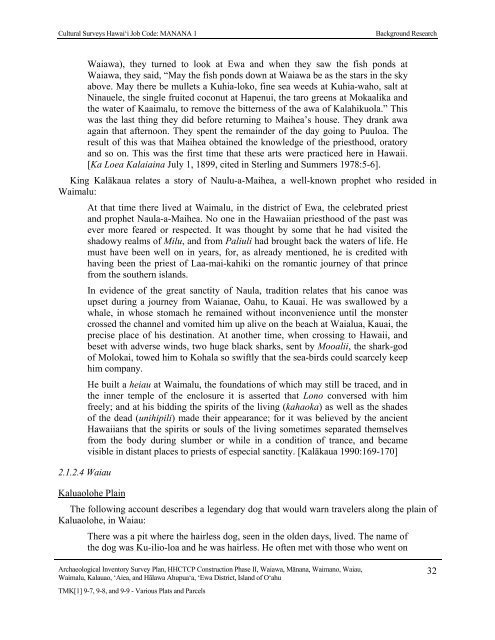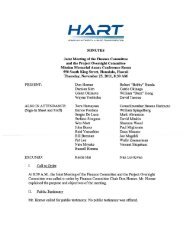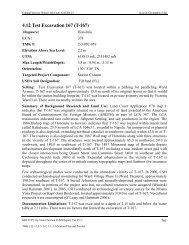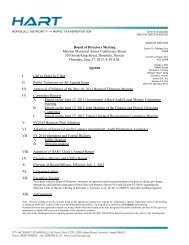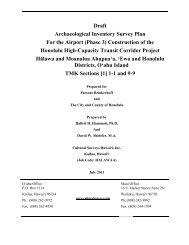AISP Kamehameha Highway Guideway - Honolulu Rail Transit Project
AISP Kamehameha Highway Guideway - Honolulu Rail Transit Project
AISP Kamehameha Highway Guideway - Honolulu Rail Transit Project
Create successful ePaper yourself
Turn your PDF publications into a flip-book with our unique Google optimized e-Paper software.
Cultural Surveys Hawai‘i Job Code: MANANA 1<br />
Background Research<br />
Waiawa), they turned to look at Ewa and when they saw the fish ponds at<br />
Waiawa, they said, “May the fish ponds down at Waiawa be as the stars in the sky<br />
above. May there be mullets a Kuhia-loko, fine sea weeds at Kuhia-waho, salt at<br />
Ninauele, the single fruited coconut at Hapenui, the taro greens at Mokaalika and<br />
the water of Kaaimalu, to remove the bitterness of the awa of Kalahikuola.” This<br />
was the last thing they did before returning to Maihea’s house. They drank awa<br />
again that afternoon. They spent the remainder of the day going to Puuloa. The<br />
result of this was that Maihea obtained the knowledge of the priesthood, oratory<br />
and so on. This was the first time that these arts were practiced here in Hawaii.<br />
[Ka Loea Kalaiaina July 1, 1899, cited in Sterling and Summers 1978:5-6].<br />
King Kalākaua relates a story of Naulu-a-Maihea, a well-known prophet who resided in<br />
Waimalu:<br />
At that time there lived at Waimalu, in the district of Ewa, the celebrated priest<br />
and prophet Naula-a-Maihea. No one in the Hawaiian priesthood of the past was<br />
ever more feared or respected. It was thought by some that he had visited the<br />
shadowy realms of Milu, and from Paliuli had brought back the waters of life. He<br />
must have been well on in years, for, as already mentioned, he is credited with<br />
having been the priest of Laa-mai-kahiki on the romantic journey of that prince<br />
from the southern islands.<br />
In evidence of the great sanctity of Naula, tradition relates that his canoe was<br />
upset during a journey from Waianae, Oahu, to Kauai. He was swallowed by a<br />
whale, in whose stomach he remained without inconvenience until the monster<br />
crossed the channel and vomited him up alive on the beach at Waialua, Kauai, the<br />
precise place of his destination. At another time, when crossing to Hawaii, and<br />
beset with adverse winds, two huge black sharks, sent by Mooalii, the shark-god<br />
of Molokai, towed him to Kohala so swiftly that the sea-birds could scarcely keep<br />
him company.<br />
He built a heiau at Waimalu, the foundations of which may still be traced, and in<br />
the inner temple of the enclosure it is asserted that Lono conversed with him<br />
freely; and at his bidding the spirits of the living (kahaoka) as well as the shades<br />
of the dead (unihipili) made their appearance; for it was believed by the ancient<br />
Hawaiians that the spirits or souls of the living sometimes separated themselves<br />
from the body during slumber or while in a condition of trance, and became<br />
visible in distant places to priests of especial sanctity. [Kalākaua 1990:169-170]<br />
2.1.2.4 Waiau<br />
Kaluaolohe Plain<br />
The following account describes a legendary dog that would warn travelers along the plain of<br />
Kaluaolohe, in Waiau:<br />
There was a pit where the hairless dog, seen in the olden days, lived. The name of<br />
the dog was Ku-ilio-loa and he was hairless. He often met with those who went on<br />
Archaeological Inventory Survey Plan, HHCTCP Construction Phase II, Waiawa, Mānana, Waimano, Waiau,<br />
Waimalu, Kalauao, ‘Aiea, and Hālawa Ahupua‘a, ‘Ewa District, Island of O‘ahu<br />
TMK[1] 9-7, 9-8, and 9-9 - Various Plats and Parcels<br />
32


